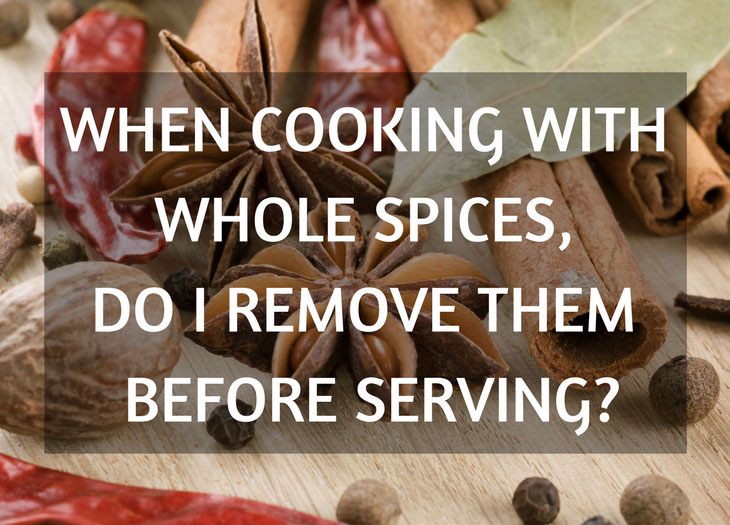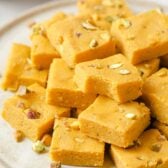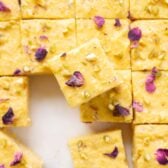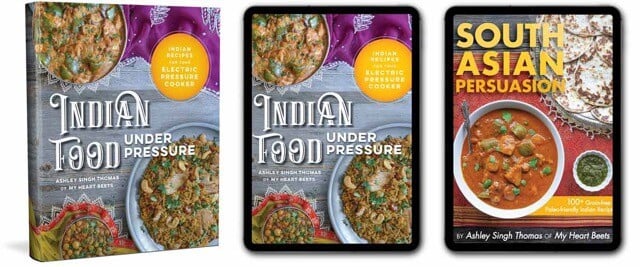When cooking with whole spices, are you supposed to remove them before serving?

So you’ve finished cooking an Indian dish, and it’s delicious! Maybe it was my chicken biryani? Or perhaps one of my curry recipes on the blog? Now that you’re done cooking, you might be wondering – what do I do with the whole spices floating around/hiding in the dish?
If you’re asking yourself that question, know that you are not alone. This is one of the things that I get asked about ALL. THE. TIME.
And after answering this question in text messages, via email, in blog comments, and on social media, I’ve decided that it’s finally time to write a blog post about this because clearly, this is a question that needs answers.
How do you discard whole spices? The short answer is that you have a few options:
If you don’t want to read this whole post, here’s the short answer: move the spices to the side of your plate as you eat (give those eating a heads up to do the same). Or fish through the dish and remove them yourself (e.g., if you added 5 cardamom pods to the dish, remember to remove the 5 cardamom pods). Another idea is to fry the larger whole spices (cinnamon, clove, cardamom, bay leaf) in oil, remove them with a spoon and place them into either a teabag pouch or a metal tea strainer.
Now, here’s the long answer:
What do I do with my whole spices once I’m done cooking an Indian dish?
Do I leave whole spices in the curry? Do I pick them out? Do I warn my guests?
Most of us who grew up in an Indian household are familiar with whole spices and know to move them to the side of our plate as we eat. I’m sure, at some point, every Indian person has accidentally bitten into a clove or cardamom pod. What do we do when that happens? Either eat it or spit it out. 🤷🏽♀️
It’s like eating an olive with a pit. You obviously don’t eat the pit.
No one gets annoyed about eating olives with pits, right? Think of large whole spices the same way.
Sure, biting into a clove isn’t the tastiest thing and can be kind of off-putting if you’re not used to it, but it comes with the Indian food territory. That’s how you know you’re eating some real deal Indian food – when the chef/cook doesn’t care to remove the whole spices (lol).
We are taught from a young age to look for whole spices as we eat. Honestly, I’m not even sure if it’s something we’re actually taught. I think it’s just something we learn… probably after biting into a clove as a kid. My toddler bit into his first clove a few months ago when he was around 15 months old. He made a face to show me that he wasn’t pleased… I’m sure I did the same thing as a kid.
Which whole spices are you not supposed to eat? Which ones are you supposed to eat?
You can, of course, search for whole spices as you eat – some of them are really easy to spot, like cinnamon sticks, star anise, or bay leaves. The trickier whole spices to find are cardamom pods and cloves. And what about curry leaves? Some people eat them, and some don’t. I personally don’t unless the leaves are small.
Then there are the whole spices that you’re supposed to eat – those are the tiny ones like cumin seeds, mustard seeds, and fennel seeds. You can also eat slightly larger ones like coriander seeds and black peppercorns.
That said, what do I do? Personally, when I’m serving Indian food to family, I leave the whole spices in the dish. If I’m having friends over who are not Indian, then I’ll either remove the whole spices myself or give them a heads up – letting them know there might be whole spices in their meal.
I Don’t Like That Answer. I Don’t Want to Bite into Whole Spices. What Else Can I do?
First, I’m going to tell you what NOT to do. Do not substitute whole spices with ground spices to avoid this issue. If a recipe calls for frying whole spices in oil, there’s a reason for it!
There was a good discussion in my facebook group about workarounds to this whole spices issue, and several people suggested using teabag pouches or a metal tea strainer. If you decide to do this, I would first fry the whole spices in oil, then after they have roasted in oil, use a spoon to scoop them into the pouch. This way, they will flavor the oil and then continue to flavor the dish through the pouch.
A simple but effective idea: remember the number of whole spices you use and remove them. If you use 5 whole cardamom pods, then make sure to remove 5 pods at the end. This is a lot easier when you count them out.
I realize that leaving whole spices in a dish is a pretty foreign concept to anyone who isn’t Indian, so I hope this post was helpful! If you have any tips, leave a comment letting us know what you do!
If you did find this helpful, check out the other posts in my Indian Cooking 101 Series!






John says
Great insights on handling whole spices in Indian cooking! It’s so helpful to know how to manage them for a better dining experience. Thanks for sharing this useful tip!
Ashley - My Heart Beets says
Thanks John!
Lyss says
Because I’m not Indian and never knew any better, I always just ate the whole spices, and now that I’m used to them, they’re usually my favorite part! Lol, the reason I love Indian food so much is because of how flavorful it is, and the whole spices are like little firecrackers of flavor bursting in my mouth. My favorites are the cinnamon chips! They are so yummy (I use Ceylon when I cook myself, not cassia) and I love the chewy texture they add. Is there any reason I shouldn’t be eating them? Or is it okay to continue to do so?
Cody says
The day someone opens up a shop that sells Indian food with the spices (and bones) removed before serving, he or she will become a millionaire overnight. Two words: “Spice Infuser.” You get all the same flavor without having the sticks and pebbles and leaves and such making the process of actually eating the food so tedious. In my town, about 7 new sit down Indian restaurants and at least 20 new Indian food trucks – no exaggeration – have opened up in the past year. Every single one of them serves similar things, always with the sticks and leaves and pebbles all in there, despite knowing that their audience is going to be primarily Americans who almost universally prefer their food without having to pick things out of it, spit things out, etc. while eating. It seems so strange to me that it has not occurred to so much as even a single ONE of these restaurants that tailoring the serving prep style to suit the customer might be a good idea. I love Indian food, but I really do hate having to pick around at it to be able to eat it.
Harriette says
I’ve mistakenly bit into some whole spices in many different dishes, Indian or otherwise. Some are not so pleasant like whole black pepper or ginger. 😆
David says
this adds amusement to our family meal, cassia bark is easy to find but when someone bites into a cardamom pod (it is not nasty, just strong in flavour) the look on their face and as to whether they carry on or removing it, a test of their strength and determination.
Ashley - My Heart Beets says
This is the best comment hahah. I love this!